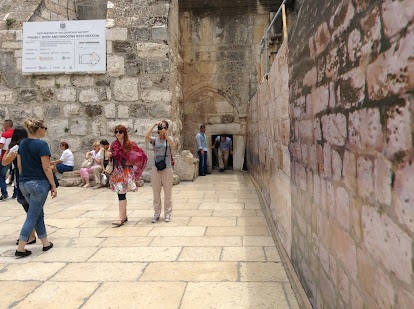This blog is a continuation of the recent entry on the Tour of Israel in late May to early June 2014 (Read here).
*************************************************
After the visit to the Shepherd's Field (
Read here), we continued to the Church of Nativity in Bethleham.
To enter the Church of Nativity, everyone needs to stoop low in order to clear the 1.2 m high main entrance door. At a glance, there is clear profile around this door opening that the original entrance was at least twice its current height. Story has it that in around 1500 AD during the time of Ottoman Empire, the entrance door was deliberately made smaller to prevent looters from driving their carts on donkeys and horses inside to carry off their booty. Conveniently, this door is now called the Gate of Humility, a reminder to all visitors to bow low before entering the place where God humbled himself to become man.
**************************************************
 |
| Courtesy of Time Graphic by Ed Gabel. |
At the time of our visit on 31 May 2014, the Basilica was undergoing major restoration after it was listed as a World Heritage Site by UNESCO in 2012. The restoration involved the roof, walls and mosaics.
Old floor mosaics.
A staircase in the Basilica leads down to the Grotto of Nativity. At the Grotto of Nativity, a silver star marks the spot where it is believed Jesus was born (Photos with courtesy from websites).
On the day of our visit, the queue to the Grotto of Nativity was massive. We decided to forego our attempt to see the spot.
************************************************
Today, St. Catherine Church adjacent to the Basilica continues to welcome both locals and visitors. Annual Christmas service in this Church is normally telecast live around the world.
Statute of St. Jerome in the courtyard and statute of St. Catherine at the roof of the Church.
St. Catherine Church has a magnificent interior. At the nave, there is a prominent stained glass which depicts the scene of nativity.
A staircase next to the nave leads down to a complex network of caves and rock-cut chambers. We reached the grotto of St. Jerome. Jerome, an ascetic also known as Eusebius Hieronymus stayed in a cave beneath the Church to translate the Bible from Hebrew and Greek into Latin. He started the translation in 386 AD and spent the next 30 years doing it. His translation known as vulgate remained an authoritative version used by the Catholics until the 20th century.
 |
| Grotto of St. Jerome. |

It is said that at the grotto of the Holy Innocents, remains of children under two years ordered killed by King Herod at the time of Jesus birth are buried.
*************************************************
At the Franciscan Courtyard.

























No comments:
Post a Comment